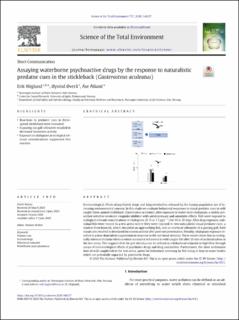| dc.contributor.author | Höglund, Erik | |
| dc.contributor.author | Øverli, Øyvind | |
| dc.contributor.author | Åtland, Åse | |
| dc.date.accessioned | 2020-11-16T14:18:35Z | |
| dc.date.available | 2020-11-16T14:18:35Z | |
| dc.date.created | 2020-08-18T09:47:48Z | |
| dc.date.issued | 2020 | |
| dc.identifier.citation | Science of the Total Environment. 2020, 737 . | en_US |
| dc.identifier.issn | 0048-9697 | |
| dc.identifier.uri | https://hdl.handle.net/11250/2688073 | |
| dc.description.abstract | Ecotoxicological effects of psychiatric drugs and drug metabolites released by the human population are of increasing environmental concern. In this study we evaluate behavioral responses to visual predator cues in wild caught three-spined stickleback (Gasterosteus aculeatus) after exposure to water-born citalopram, a widely prescribed selective serotonin reuptake inhibitor with antidepressant and anxiolytic effects. Fish were exposed to ecological relevant concentrations of citalopram (0.15 or 1.5 μg L−1) for 10 or 20 days. After drug exposure, individual fish were moved to a test arena where they were exposed to two naturalistic visual predator cues; a shadow from beneath, which simulated an approaching fish, and an overhead silhouette of a passing gull. Both visual cues resulted in decreased locomotor activity after post cue presentation. Notably, citalopram exposure resulted in a dose dependent suppression in response to the overhead stimulus. These results show that an ecologically relevant stimulus elicits a robust avoidance behavioral in wild caught fish after 25 min of acclimatization in the test arena. This suggests that the gull stimulus can be utilized as a behavioral endpoint in high flow through assays of ecotoxicological effects of psychiatric drugs and drug metabolites. Furthermore, the short acclimation time of wild caught fish in the test arena, opens for behavioral screening by fish living or kept in water bodies which are potentially impacted by psychiatric drugs. | en_US |
| dc.language.iso | eng | en_US |
| dc.rights | Attribution-NonCommercial-NoDerivatives 4.0 Internasjonal | * |
| dc.rights.uri | http://creativecommons.org/licenses/by-nc-nd/4.0/deed.no | * |
| dc.title | Assaying waterborne psychoactive drugs by the response to naturalistic predator cues in the stickleback (Gasterosteus aculeatus) | en_US |
| dc.type | Peer reviewed | en_US |
| dc.type | Journal article | en_US |
| dc.description.version | publishedVersion | en_US |
| dc.source.pagenumber | 5 | en_US |
| dc.source.volume | 737 | en_US |
| dc.source.journal | Science of the Total Environment | en_US |
| dc.identifier.doi | 10.1016/j.scitotenv.2020.140257 | |
| dc.identifier.cristin | 1823757 | |
| dc.relation.project | Norges forskningsråd: 160016 | en_US |
| dc.source.articlenumber | 140257 | en_US |
| cristin.ispublished | true | |
| cristin.fulltext | original | |
| cristin.qualitycode | 2 | |

